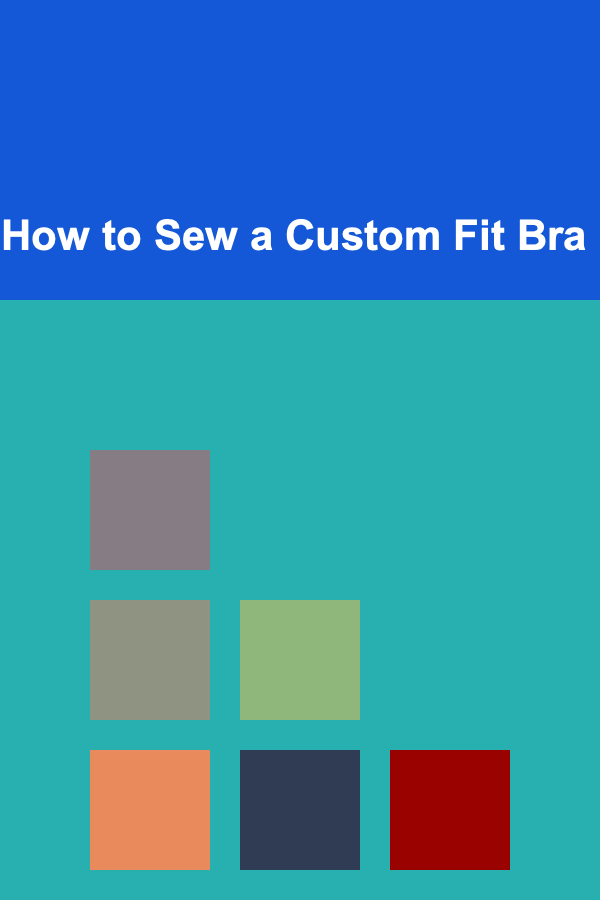
How to Sew a Custom Fit Bra
ebook include PDF & Audio bundle (Micro Guide)
$12.99$10.99
Limited Time Offer! Order within the next:

Making your own custom fit bra can be a rewarding and empowering experience. Not only do you get the satisfaction of creating something unique, but you also ensure that the fit is tailored to your own body, providing comfort and support that off-the-shelf bras might not offer. However, sewing a bra can be a challenging task for beginners, as it involves understanding fabric choice, pattern fitting, and sewing techniques that are different from basic garment construction. In this article, we'll go through the detailed process of sewing a custom fit bra, step by step, so you can craft a comfortable and stylish piece of lingerie.
Understanding the Importance of Fit
A good bra does much more than support; it shapes, lifts, and helps to create a smooth silhouette under clothing. A custom fit bra is tailored to your unique measurements, which ensures comfort, function, and a better overall fit. Unlike ready-made bras, which are designed to fit a broad range of body types, a custom-fit bra allows you to choose fabrics, styles, and features that suit your personal preferences. But before you begin sewing, understanding how a well-fitted bra should fit is crucial.
Key Components of Bra Fit
- Band: The band is the foundation of the bra and provides the majority of the support. It should fit snugly around your ribcage, providing support without riding up.
- Cups: The cups should fully encompass your breasts without gaps or overflow. The center gore (the space between the cups) should rest flat against your sternum.
- Straps: Straps should not dig into your shoulders or slip off. They should be adjusted so they provide support without bearing the full weight of your breasts.
- Underwire: If you are using an underwired pattern, the underwire should sit comfortably along your ribcage, encircling the breast tissue without poking.
By understanding these elements, you can make adjustments as needed to achieve the perfect fit when sewing your custom bra.
Materials and Tools Needed
Before you start, it's important to gather all the necessary materials and tools to make the process as smooth as possible. Here's a list of essential items you'll need:
Fabric and Notions
- Bra Fabric: Choose a fabric with the right amount of stretch. Popular options include jersey, cotton blends, lace, satin, and microfiber. For a sturdy, supportive bra, you might want a combination of stretchy fabric for the cups and firmer fabric for the band.
- Underwire (Optional): If you prefer an underwired bra, you will need underwire channels and actual underwires. If you want a non-underwired bra, you can skip this step.
- Bra Straps: You'll need adjustable elastic straps that are designed for bras. These can be purchased in a variety of widths and colors to match your fabric.
- Elastics: For the band and underarm areas, you'll need lingerie elastic, which is soft and stretches slightly to provide a snug, but comfortable fit.
- Hook and Eye Closures: These closures are used at the back of the bra to secure it around your body. They come in various sizes depending on your band measurement.
- Seam Tape: This helps stabilize seams, ensuring that your bra stays together without losing shape.
- Bra Padding (Optional): If you want extra padding or shaping, you can add foam pads into the cups.
Tools
- Sewing Machine: A basic sewing machine will work for the majority of the sewing tasks. However, a machine with a zigzag stitch or stretch stitch is highly recommended for working with elastic and lingerie fabric.
- Sewing Needles: Use a ballpoint needle for knits and a universal needle for most fabrics.
- Thread: Choose a strong, durable thread, preferably one designed for lingerie or stretch fabrics. Polyester thread is ideal for this type of project.
- Measuring Tape: Accurately measuring your body is essential to creating a custom-fit bra.
- Pins or Fabric Clips: Use these to hold pieces together before sewing.
- Pattern Paper: You can use an existing bra pattern or create your own by taking precise measurements.
- Fabric Scissors: Use sharp scissors to ensure clean cuts in your fabric.
Step 1: Take Accurate Measurements
The first and most important step in sewing a custom fit bra is taking accurate measurements of your body. The key measurements required are your band size and cup size. Here's how to take them:
Band Size
- Measure around your ribcage, just under your bust. Keep the tape snug, but not tight.
- Round the measurement to the nearest whole number.
- Add 4 inches if the number is even or 5 inches if it is odd. This will give you your band size.
Cup Size
- Measure around the fullest part of your bust, making sure the tape is level across your back and not too tight.
- Subtract your band measurement from the bust measurement. The difference will determine your cup size. For example:
- 1-inch difference = A cup
- 2-inch difference = B cup
- 3-inch difference = C cup
- And so on.
Note that cup sizes can be adjusted if you prefer more or less padding. Once you have these measurements, you can find or create a bra pattern that fits those dimensions.
Step 2: Choose and Prepare Your Pattern
You can either use a pre-made bra pattern or draft your own. Many sewing patterns for bras are available online, including options for different styles (e.g., balconette, full coverage, plunge, etc.).
Adjusting the Pattern
Once you've chosen a pattern, it's crucial to make sure it corresponds with your measurements. Even with a pre-made pattern, some adjustments are often needed for the best fit:
- Adjust the Band: If the band size is too large or small, make the necessary adjustments before cutting your fabric. You can do this by either adding or removing length from the band.
- Adjust the Cup Size: To adjust the cup size, you can add or remove fabric from the pattern pieces. If your bust measurement doesn't match the pattern's cup size, you might need to use a different size for the cups while keeping the band the same size.
- Check the Cup Shape: The shape of the cups should follow the natural curve of your bust. If the pattern's cup doesn't align with your measurements, you may need to reshape or modify the pattern slightly.
Once you're satisfied with the pattern adjustments, transfer it to your fabric using pattern paper.
Step 3: Cutting Your Fabric
After preparing your pattern and fabric, it's time to cut your pieces. Carefully cut out the following components, as per your pattern:
- Cups: Cut out two pieces for each cup (one for the inner and one for the outer layer of fabric).
- Band: Cut out the band pieces as per the pattern, ensuring that there is enough fabric for the width of the band and the necessary closures.
- Straps: Cut the straps, keeping in mind how long you'll need for a comfortable fit.
- Lining (Optional): If you prefer additional structure or comfort, you can add a lining to the cups or band.
Make sure to cut fabric pieces with enough seam allowance, usually about 1/4 inch to 1/2 inch, depending on your pattern.
Step 4: Sewing the Bra Cups
Now that your fabric is cut, it's time to start sewing the bra together.
Attaching the Cups
- Sew the Side Seams: Begin by sewing the side seams of each cup together. Use a stretch stitch or a zigzag stitch to ensure the seams have some give.
- Join the Cup Pieces: Once you have the side seams done, attach the inner and outer cup pieces together by matching the edges. Use a zigzag stitch for a flexible and secure seam.
- Sew the Upper Edge of the Cup: Finish the upper edge of the cups with a soft elastic, ensuring the edge fits comfortably around the top of your bust.
Step 5: Constructing the Bra Band
The band provides the structure and support for the bra, so getting it right is crucial. To construct the band:
- Sew the Band Pieces: Attach the band pieces together at the sides, ensuring the fit around your ribcage is snug.
- Add Elastic: Use elastic to finish the edges of the band, stretching it slightly to ensure a comfortable yet firm fit.
- Install Hook and Eye Closure: Attach the hook and eye closure at the back of the band. Make sure the closure is centered and securely attached.
Step 6: Attaching the Straps
Straps should be attached to the front of the bra cups and adjusted to provide a secure fit without digging into the shoulders. To do this:
- Attach Strap Rings: Attach small rings to the upper corners of each cup.
- Sew the Straps: Sew the adjustable straps onto the rings, making sure the length is appropriate for your body size.
Step 7: Final Fitting and Adjustments
After your bra is assembled, it's time to try it on and make any necessary adjustments:
- Check the Band Fit: The band should fit snugly around your ribcage without riding up or being too tight.
- Check the Cup Fit: Ensure that the cups fully contain the breast tissue and there is no gaping or spillage.
- Adjust the Straps: The straps should provide support without digging into your shoulders or slipping off.
- Refine the Shape: If needed, make any final adjustments to the cup shape or band width to achieve the perfect fit.
Conclusion
Sewing a custom fit bra can be a challenging yet incredibly rewarding project. With the right tools, measurements, and techniques, you can create a bra that fits you perfectly, offering the support, comfort, and style you desire. From understanding the importance of fit to choosing the right fabrics and pattern adjustments, every step is crucial in making a high-quality, custom-fitted bra. So, whether you're a seasoned seamstress or a beginner, don't be intimidated---take your time, practice, and soon you'll have a collection of bras that fit you like a glove.
Reading More From Our Other Websites
- [Organization Tip 101] How to Choose the Right Chimney Cap for Your Home
- [Biking 101] How to Adjust Your Bike Stem for Better Control and Handling
- [Soap Making Tip 101] Eco-Friendly Soap Making: How to Reduce Waste with Zero-Packaging Recipes
- [Soap Making Tip 101] Bubbly Fun: Simple Soap-Making Projects Kids Can Master
- [Small Business 101] Small Business Resources: Free Tools and Support to Help You Grow
- [Home Pet Care 101] How to Prepare for a Safe and Stress-Free Pet Travel Experience
- [Personal Investment 101] How to Choose Between ETF vs Mutual Fund for Your Retirement Savings
- [Home Soundproofing 101] How to Use Acoustic Panels to Soundproof Your Home
- [Small Business 101] How to Create a Seamless Remote Hiring Process for a Growing Small Business
- [Gardening 101] How to Start and Care for Your Succulent Garden

How to Create a Checklist for Effective Project Documentation
Read More
How to Market and Sell Digital Art Portfolios: An Actionable Guide
Read More
How to Organize Furniture for Optimal Flow During Showings
Read More
Top Strategies for Effectively Utilizing Credit Card Rewards
Read More
10 Tips for Simplifying Your Family To-Do List with Technology
Read More
How to Write Poetry That Evokes Emotion
Read MoreOther Products

How to Create a Checklist for Effective Project Documentation
Read More
How to Market and Sell Digital Art Portfolios: An Actionable Guide
Read More
How to Organize Furniture for Optimal Flow During Showings
Read More
Top Strategies for Effectively Utilizing Credit Card Rewards
Read More
10 Tips for Simplifying Your Family To-Do List with Technology
Read More